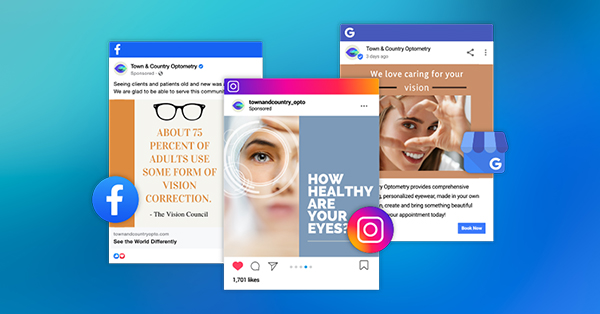How To Add Dry Eye Marketing Into Your Content Strategy
According to an article published on the official website of the American Academy of Ophthalmology, there are two interesting statistics regarding dry eye disease (DED):
- Approximately 20 million people in the United States have dry eye disease (DED), increasing across all ages mainly due to increased screen time and environmental factors.
- About half of those affected by dry eye disease are not seeking professional treatment.
Whether it’s pure neglect or lack of knowledge, one thing is for sure; there is a huge untapped market for untreated patients with dry eye disease seeking symptom relief. What better way to grow your clientele than to use terms many patients search for related to dry eyes in your content marketing mix?
This can be creating blogs that talk about dry eye relief, infographics about the best type of contact lenses or eye drops, and even videos that can point out signs of dry eye disease and how to prevent it. Here is a list of things you can do to your marketing strategy to incorporate this common condition amongst your patients.
Understanding Your Audience: The Cornerstone of Effective Marketing
An understanding of the audience you are targeting is imperative for incorporating dry-eye marketing into your overall content strategy. This way, you can come up with campaigns that have a personal appeal and enhance their trust in your practice as an authority. Below are a few ideas that have stood the test of time.

Conduct Thorough Research on Your Audience
To understand your patients, do thorough research regarding demographics, psychographics, and specific behaviors. With tools like social media and patient surveys, it is possible to get relevant information about their lives, challenges, and aspirations. For instance, if most of your patients don’t know about advanced available treatments for dry eye conditions then you can use this information in developing your content strategies.
Create Extensive Buyer Personas
Build detailed avatars of your ideal customers using data-driven insights. For example, Sarah, a 35-year-old marketing manager, has dry eyes due to long hours spent staring at her computer screen every day. Humanizing the people you want to reach out to through advertisements or other means of communication can enable you to tailor messages that will create meaning out of consumers’ needs and wants.
Messaging with Empathy and Expertise in Mind
Develop messages that touch on the feelings and aspirations of your target audience. You have to prove beyond doubt that your practice is very familiar with dry eye disease and therefore a credible source for information.
For example, instead of merely listing out various treatments available to your patients, include how they can improve their overall quality of life.
Keyword Research: Building the Foundation for SEO Success

Understanding SEO and Its Importance
SEO is the abbreviation of Search Engine Optimization and refers to the act of enhancing your website and content in order to increase its position on search engine result pages (SERP). Increased visibility achieved through higher rankings may help you attract more patients to your practice.
On-Page SEO: The Essentials
Title Tags: Design captivating titles that incorporate keywords into each page’s subject matter accurately. For instance, it is possible for a blog post entitled “Effective Treatments for Dry Eye Syndrome” with a meta description highlighting common treatments and symptoms to draw those searching for treatments.
Meta Descriptions: Write brief but comprehensive meta descriptions containing target keywords that would prompt users to click on your link. A good meta might read thus; “Best Treatments for Dry Eye Syndrome – From Artificial Tears to Advanced Therapies.”
Headers: Use header tags (H1, H2, H3, etc.) to organize your information and bring out the main points that are easily understandable by both search engines and users. For example, use headers like “Understanding Dry Eye Syndrome” (H1) than subheaders such as “Common Causes of Dry Eye” (H2).
Images: Optimize images using descriptive file names and adding alt text to improve accessibility and search engine understanding. For example, use “dry-eye-treatment-options.jpg” and alt text like “Various treatment options for dry eye syndrome.”
Conducting Effective Keyword Research

Keyword Research Tools
Use tools like Google Keyword Planner or SEMrush to determine the most relevant keyword for your dry eye content. These tools can be used to identify keywords that people in your target audience are searching for, so you can create content that caters to their needs.
You may start by entering general terms related to dry eye problems including “dry eye”, and “dry eye symptoms”. Analyze the search volume, competition, and relevance of these keywords to identify which ones to focus on. The number of searches performed signifies a popular word while low contestation refers to an easier way of getting higher ranks.
Keywords Analysis and Selection
Check if the identified keywords match with your clinic’s goals and content planning. Think about long-tail words phrases which tend to have less competition but attract more specific traffic. For instance, “best eye drops for dry eyes relief” or “treatment options for dry eye syndrome” would be good keywords targets.
Specific Actionable Tips for Dry Eye Keyword Research
Identify Patient Concerns
Create content that directly addresses your patients’ concerns by using key terms such as “dry eye symptoms” and “dry eye causes”. In addition to speaking your reader’s language, you are targeting highly relevant secondary keywords that are topically related to boost your SEO.
Highlight Treatments and Solutions
People who need solutions to their problems type in keywords like “how to treat dry eyes,” “dry eye options,” and “eye drops for dry eyes.” Your content should have as much detail as possible regarding these therapies.
Leverage Local SEO
Local patients browsing around searching for nearby care can be attracted with location-specific keyword terms such as “dry eye specialist in [Your City].” Optimize your Google My Business listing to show up in local searches.
Optimizing Your Content
Integrating keywords naturally into your content is crucial for both SEO and readability. Here’s how to do it effectively:
Title Tags and Meta Descriptions
Ensure that your title tags and meta descriptions include your primary keywords. For instance, a page on “Dry Eye Syndrome Treatments” should have a title tag like “Effective Dry Eye Syndrome Treatments | Your Practice Name” and a meta description such as “Learn about the most effective treatments for dry eye syndrome, including medication, lifestyle changes, and more.”
Headers and Subheaders
Use headers (H1, H2, H3) to break down your content into easily digestible sections. For example, in a blog post about managing dry eye symptoms, use headers like “Common Symptoms of Dry Eye” (H2) and “How to Relieve Dry Eye Symptoms” (H3). This not only improves SEO but also enhances user experience.
Content Integration
Incorporate your keywords naturally within the body of your content. Avoid keyword stuffing, which can negatively impact readability and SEO. Instead, focus on providing valuable information. For example, discuss how regular eye exams can help diagnose and manage dry eye syndrome, or explain the benefits of different treatment options.
Optimizing Images
Images are a key component of engaging content. Optimize images by using descriptive file names and adding alt text that includes relevant keywords. For example, an image of an eye drop bottle could have a file name like “dry-eye-treatment-eye-drops.jpg” and alt text such as “Eye drops used for treating dry eye syndrome.”
Specific Actionable Tips for Dry Eye Content Optimization

Create In-Depth Guides
Develop comprehensive guides on dry eye causes, symptoms, and treatments. Use keywords throughout the guide, such as “comprehensive dry eye treatment guide” or “dry eye symptoms and solutions.”
Patient Testimonials
Share patient success stories. Use keywords like “dry eye treatment success stories” to enhance SEO while building trust with potential patients.
FAQ Pages
Create an FAQ page addressing common questions about dry eye. Include questions like “What are the best treatments for dry eye?” and “How can I prevent dry eye symptoms?” to target relevant keywords.
By thoroughly researching keywords and optimizing your content accordingly, you can create a robust SEO strategy that enhances your practice’s visibility and attracts more patients. This targeted approach not only improves your search engine rankings but also ensures that your content is valuable and relevant to your audience.
Improving and Optimizing Your Website for Dry Eye Condition

In today’s digital age, your website is often the first point of contact between your practice and potential patients. It’s crucial to have a website that not only informs but also engages patients seeking relief from this common condition. Here is how you can improve and optimize your website to better serve those with dry eye conditions.
Create a Dedicated Dry Eye Hub
Develop a section of your website devoted entirely to dry eye. This hub should include a main page introducing the condition, with sub-pages covering various aspects such as:
- Symptoms and Causes
- Diagnosis and Testing
- Treatment Options
- At-Home Care and Prevention
- Advanced Therapies (e.g., IPL, LipiFlow)
Optimize On-Page Elements for Dry Eye Content
Optimizing on-page elements is crucial for improving your website’s SEO and user experience. Here are some specific strategies for your dry eye content:
Title Tags
Craft compelling and keyword-rich titles that accurately reflect the content of each page. For example, use a title tag like “Effective Dry Eye Ti[s| [Your Practice Name].” This not only helps with SEO but also clearly communicates the focus of the page to users.
Meta Descriptions
Write concise and informative meta descriptions that include target keywords and encourage users to click on your link. An effective meta description might read, “Discover advanced dry eye treatments at [Your Practice]. We offer comprehensive care from artificial tears to cutting-edge therapies. Schedule your consultation today.”
Headers
Use headers to structure your content and make it easier for search engines to understand your page’s hierarchy. For instance, use H1 for main topics like “Understanding Dry Eye Syndrome” and H2 for subtopics such as “Common Causes of Dry Eye.” This not only helps with SEO but also improves the readability of your content. Try to get as deep as possible within the header hierarchy in a natural way whenever there’s scope.
Images
Optimize images by using descriptive file names and alt text to improve accessibility and search engine understanding. For example, use a file name like “advanced-dry-eye-treatment-ipl.jpg” and alt text like “Intense Pulsed Light (IPL) treatment for dry eye syndrome.” High-quality images with appropriate tags can enhance the visual appeal of your website while also contributing to SEO.
Showcase Your Expertise
Feature the credentials of your doctors who specialize in dry eye management and showcase any advanced equipment or cutting-edge treatments you offer.
Embed your staff’s LinkedIn that reaffirms their authority and credibility.
Enhance User Experience
Consider the needs of your target audience when designing your dry eye pages. Implement a soothing design with eye-friendly color schemes and use larger, easy-to-read fonts for comfortable viewing. Ensure your site is mobile-responsive, allowing patients to access information easily on any device.
Competitor analysis can be highly beneficial in various ways when it comes to SEO. Understanding best practices in terms of implementing a modern design that’s clean minimalistic by applying the principles of UI/UX design goes a long way.
Implement Clear Call-to-Actions (CTAs)

Guide your website visitors towards taking action. Include specific CTAs for dry eye consultations on each sub-page. Use compelling, urgency-driven language to encourage immediate booking of appointments.
Integrate Patient Testimonials and Reviews
Build trust by including success stories from dry eye patients. Consider using video testimonials for a more personal touch, allowing potential patients to hear directly from those who’ve benefited from your care.
Implement Schema Markup for Dry Eye Content
Utilize the ‘Medical Condition’ schema for your dry eye syndrome pages. This schema provides detailed information about the condition, including symptoms, causes, and treatments, which can enhance the visibility of your pages in search results.
Finally, use the ‘FAQ’ schema for your dry eye FAQ page. This structured data format allows you to present commonly asked questions and their answers in a way that is easily understood by search engines, improving the likelihood of appearing in featured snippets and other prominent positions in search results.
Implement Local SEO Strategies
Optimize your Google My Business listing with dry eye-specific information. Create location-specific landing pages for multi-location practices. Encourage and manage patient reviews from dry eye patients. Include keywords that have ‘local’ intent.
Content Ideas: Engaging and Informative Strategies
Creating engaging and informative content about dry eye cause, symptoms, diagnosis, and treatment can attract and retain your audience’s attention. Here are some creative ideas to transform various pieces of information about dry eye into engaging content for social media, emails, and blog posts:
Common Causes of Dry Eye
- Aging
- Environmental factors
- Screen time
- Medications
Interactive Infographics:
Develop interactive infographics that illustrate the common causes of dry eye, such as aging, environmental factors, screen time, and medications. These visuals can simplify complex information and make it easy to understand.
Animated Videos
Create short animated videos explaining how factors like aging and prolonged screen time contribute to dry eye. Animation can make the content more engaging and shareable on social media.
Common Symptoms of Dry Eye
- Redness
- Irritation
- Burning sensation
- Blurred vision
- Feeling something in the eye
Symptom Checker Tool
Develop an online tool where users can input their symptoms and receive feedback on whether they might be experiencing dry eye. This tool can drive traffic to your website and encourage users to book an appointment.
Illustrated Guides
Use illustrated guides to show the symptoms of dry eye. Visual aids can help readers better understand the symptoms and recognize them in their own experiences.
Types of Dry Eye

Aqueous Deficient Dry Eye & Evaporative Dry Eye
Comparison Charts
Create comparison charts that highlight the differences between aqueous deficient dry eye and evaporative dry eye. This can help patients understand their condition better and the specific treatments available.
Case Studies
Share case studies of patients with each type of dry eye, detailing their symptoms, diagnosis, and treatment journey. Real-life stories can resonate more with readers and build trust.
Diagnosis of Dry Eye
Professional Examination
Behind-the-Scenes Videos
Produce videos that take viewers behind the scenes of a professional eye examination. Show the diagnostic tests being performed and explain their importance.
Q&A Sessions
Host live Q&A sessions on social media where eye care professionals answer common questions about dry eye disease and the importance of seeing an eye care professional.
Diagnostic Tests
Interactive Quiz: Develop an interactive quiz that educates users about different diagnostic tests for dry eye, such as Tear Break-Up Time (TBUT) and Schirmer’s test. Quizzes can make learning fun and engaging.
Explaining Other Common Eye Conditions
Myopia, Hyperopia, Astigmatism
Infographic Series
Create a series of infographics that explain each eye condition, their symptoms, and treatments. Share these infographics on social media and your website to educate your audience.
Patient Testimonials
Feature testimonials from patients with these conditions discussing their experiences and how treatment has improved their quality of life.
Tips for Maintaining Good Eye Health

Importance of Regular Eye Exams
- Reminder Campaigns: Launch an email or social media campaign that reminds patients of the importance of regular eye exams. Include tips for preparing for an eye exam and what to expect.
- Educational Articles: Write articles that explain how regular eye exams can prevent or detect serious eye conditions early.
Proper Use of Digital Devices
- Digital Detox Challenges: Encourage your audience to participate in a digital detox challenge where they take regular breaks from screens and follow the 20-20-20 rule. Share tips and progress on social media.
- Healthy Habits Videos: Produce videos with tips on reducing screen time, using lubricating eye drops and protecting eyes from digital strain.
UV Protection for Eyes

- Sun Safety Campaigns: Run campaigns during the summer months focusing on the importance of UV protection for eyes. Include tips on choosing the right sunglasses and the dangers of UV exposure.
- Interactive Content: Develop interactive content that allows users to learn about UV protection through engaging formats like clickable images or interactive stories.
Maintaining a Balanced Diet
- Recipe Blog Posts: Share blog posts with recipes that promote eye health, highlighting ingredients rich in omega-3 fatty acids, vitamins A, C, and E, and antioxidants.
- Nutrition Infographics: Create infographics that showcase foods beneficial for eye health and how they help in managing dry eye treatments.
Proper Sleep
- Sleep Hygiene Guides: Develop comprehensive guides on sleep hygiene, explaining how proper sleep impacts eye health and overall well-being.
Reducing Screen Time
- Screen-Free Activities: Share ideas for screen-free activities that families can enjoy together. Encourage your audience to share their experiences and tips on social media.
- Workplace Wellness Tips: Write articles or create videos offering tips for reducing screen time at work.
Tailoring Content for Various Channels

Creating content is just the first step; it’s essential to tailor these pieces for different platforms to maximize engagement and reach. You could be using the same piece of information but how you present and format it creatively determines if a piece of content is suitable for a particular channel.
Blogs and Articles
In-Depth Guides
Craft comprehensive guides on topics like “Understanding Dry Eye Syndrome” or “Effective Treatments for Dry Eye.” These long-form articles delve deep into the causes, symptoms, and treatments, providing valuable information that positions your practice as an expert in eye care.
Case Studies
Share detailed patient success stories to build trust and credibility. For example, a case study on a patient who found relief from chronic dry eye symptoms through a specific treatment plan can be very compelling.
Educational Content
Offer insights into common eye conditions, symptoms, and preventive measures. This type of content not only educates but also reassures patients that your practice is knowledgeable and caring.
Email Campaigns

Newsletters
Include a mix of educational content, patient testimonials, and updates on new treatments or services. Regular newsletters keep your audience informed and engaged with your practice.
Promotional Offers
Share exclusive offers or discounts to incentivize bookings. Special promotions can be a great way to encourage patients to try new treatments or schedule their next appointment.
General Points to Consider for Email Marketing
To build a robust email list, collect emails through your website and social media platforms. Use lead magnets like free guides on dry eye management and simple sign-up forms to capture interested prospects.
Automate your campaigns to streamline communication. Set up welcome sequences for new subscribers, drip campaigns to nurture leads, and cart abandonment emails to recover potential patients.
Maximize engagement with personalized outreach. Use patient data to send targeted emails that address specific needs, tailoring content to individual preferences for stronger connections.
By implementing these strategies, you can build a responsive email list, create compelling content, and automate personalized communication effectively.
Social Media Posts

Bite-Sized Information
Share quick tips or interesting facts about dry eye to engage your audience. For example, a post might highlight a simple lifestyle change that can help reduce symptoms.
Visual Content
Use infographics and short videos to explain symptoms, causes, and treatments. Visual content is more likely to be shared and can help spread awareness about your services.
Patient Testimonials
Feature short quotes or video testimonials from satisfied patients. Real stories from real patients can be incredibly persuasive and help build trust with your audience.
Repurpose Your Content
Your detailed blog on ‘Dry Eye Symptoms and Possible Causes’ can easily be converted to an interesting infographic or an eBook to create a lead magnet. Always look out for opportunities to repurpose different formats of content so you get the most out of your marketing dollars.
The Bottom Line
Regular eye care is crucial. Nevertheless, people suffering from such conditions as dry eye syndrome fail to visit experts despite the significant impact on their lives. By creating attractive and educational content about eye health, you are not only promoting your practice but also providing an important public service.
However, professional services can take your strategy much further than this guide offers. iMatrix has an excellent offering in terms of professional services apart from just managing social media accounts for businesses. Their suite of comprehensive solutions is sufficient in its ability to support your practice’s growth. Visit www.imatrix.com or call 800-792-8384.



